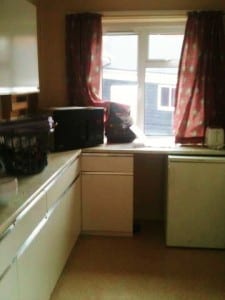“A place owes its character to the experiences it affords to those who spend time there – to the sights, sounds and indeed smells that constitute its specific ambience.” ((Ingold quoted in Pearson, Mike (2010) Site-Specific Performance, Basingstoke: Palgrave Macmillan, p.15))
For some people, a home is a place of safety and security. It is a place full of memories of their families and their childhood. For others it is somewhere to relax and unwind after a long day, shutting their troubles behind the front door. However there is something very different between a ‘home’ and a ‘house’. I think after seeing the house we will be working in for the first time, that is something everyone will agree with! There’s something about walking into a house with old fashioned peeling wallpaper, dirty and dusty skirting boards and the smell of muskiness hitting you in each room that makes you not feel at home – which already makes this a very intriguing place to be working in! “Not all spaces built by man have this character of homeliness, but they should not all have them; for not all are intended for the purpose of ‘dwelling’ in the strict sense, of feeling sheltered within them during ones stay.” ((Bollnow, O.F. (2011) Human Space, London: Hyphen Press, p.142))
Photo taken: 02/02/13 – ‘The Kitchen’
For me, the room I felt safest and most comfortable was the kitchen. This room I felt played no tricks, it was there for that purpose; to be a kitchen. Rooms such as the CCTV room was the room for spying, the cot room felt strangely eerie and held mystery (although interestingly it may not have felt this way if the cot had not been placed there), as does the main bedroom with it’s lack of furniture, yet perfectly made bed and out of place lamp. Whereas the kitchen felt like it was away from the weirdness, tucked at the back of the house, in which I could escape.
This whole idea of purpose gave me many ideas for what we could do with this space. Perhaps treating each room as if it was a different one, ignoring what it might be and its real purpose. For example the kitchen could become a bedroom using its cupboards as a wardrobe. I thought perhaps displaying pre-recorded CCTV footage on the television in the living room for the audience to watch would be interesting. This will already make the audience feel unnerved which is how I felt in most rooms of the house. “and the desire to provoke, shock, and unsettle spectators is central to the avant-garde.” ((Freshwater, Helen (2009) theatre & audience, London: Palgrave Macmillan, pp.45-46))
